Holme-on-Spalding-Moor
Holme-on-Spalding-Moor (also known as Holme-upon-Spalding-Moor) is a large village and civil parish in the East Riding of Yorkshire, England. It is situated approximately 8 miles (13 km) north-east of Howden and 5 miles (8 km) south-west of Market Weighton. It lies on the A163 road where it joins the A614 road.
| Holme-on-Spalding-Moor | |
|---|---|
 Holme Hall | |
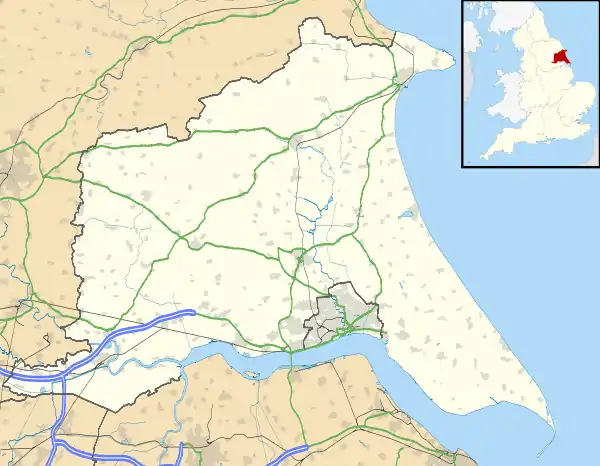 Holme-on-Spalding-Moor Location within the East Riding of Yorkshire | |
| Population | 3,172 (2011 census)[1] |
| OS grid reference | SE805385 |
| • London | 160 mi (260 km) S |
| Civil parish |
|
| Unitary authority | |
| Ceremonial county | |
| Region | |
| Country | England |
| Sovereign state | United Kingdom |
| Post town | YORK |
| Postcode district | YO43 |
| Dialling code | 01430 |
| Police | Humberside |
| Fire | Humberside |
| Ambulance | Yorkshire |
| UK Parliament | |
In terms of major cities, the village is closest to York which is just under 20 miles (32 km) away, while Hull is 23 miles (37 km) away. The civil parish is formed by the village of Holme-on-Spalding-Moor and the hamlets of Bursea, Hasholme, Tollingham and Welhambridge. According to the 2011 UK Census, Holme-on-Spalding-Moor parish had a population of 3,172,[1] an increase on the 2001 UK Census figure of 2,948.[2]
History

Holme-on-Spalding-Moor village is named for its location on the Spalding Moor. In very early censuses of England (before the 16th century) the village was sometimes listed as Holme, Spalding Moor, Yorkshire, though there is little evidence of any other towns scattered across the moor at that or any time. The word Holme is Danish of origin and means island.
Spalding Moor was a marsh, dominated by a single hill which consists of Keuper marl; on the hill a small church was built in the 13th century. The village was built on the holme around the church, hence the name. Spalding Moor now is lightly cultivated and has been largely tamed.
Through the 17th and 18th centuries, the main occupation for people in the village was growing and dressing hemp. This gave rise to it sometimes been referred to as "Hemp-Holme".
A late Iron Age logboat (750–390 BC), now known as the Hasholme Logboat, was discovered at Hasholme in the south-east of the parish.
In 1823, Holme-on-Spalding-Moor was in the Wapentake of Harthill. Baines' History, Directory and Gazetteer of the County of York records the alternative village name of "Hemp Holme", taken from the parish' former cultivation of hemp. A bed of gypsum was recorded in which ammonites were found. The church stands in an elevated position, on which is also sited a beacon, which gave its name of Holme Beacon to this contemporary part of Harthill Wapentake. The parish church and rectory was in the patronage of St John's College, Cambridge. There were two chapels, one Roman Catholic, the other, Methodist. Local landowners allotted land (cow-gates), for the personal use of their labourers. Population at the time was 1318. Occupations included twenty-three farmers and yeomen, three blacksmiths, two wheelwrights, three shoemakers, four shopkeepers, two coal dealers, two corn millers, a tailor, a butcher, a joiner, a bricklayer, and an ornamental plasterer. There were the landlords of The New Inn, The Hare and Hounds, The Sun, and The Blacksmiths' public houses. A carrier operated between the village and Market Weighton on Wednesdays, and Howden on Saturdays. Within the parish lived a banker, a steward to Lady Stourton [Mary Langdale], Charles Langdale at the Hall, a gentleman and a gentlewoman, a surgeon, and the parish rector. Baines records a traditional belief that a cell for two monks was founded at Welham Bridge on the edge of Spalding Moor by vavasours or constables. One monk was charged with guiding people over wasteland, the other praying for the safety of travellers.[3]
Holme-on-Spalding-Moor was served by Holme Moor railway station on the Selby to Driffield Line between 1848 and 1954.[4]
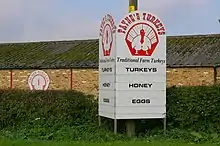
Holme Hall is a country house which was the seat of the Langdale barony. The hall was designated a Grade II* listed building in 1966 and is now recorded in the National Heritage List for England, maintained by Historic England.[5] It is now a Sue Ryder Care Home. The chapel is in use as the village's Roman Catholic church [6]
RAF
The moor was the site of a Royal Air Force station, RAF Holme-on-Spalding Moor, which was active during the Second World War and for several years thereafter as a bomber facility, being officially closed in 1954 and transferred to the U.S. Air Force. The USAF moved out in 1957, and the field was sold to a private firm.
It continued in private hands until 1984, when its last tenant, British Aerospace, moved out. It was in a rather dilapidated condition by that time, and upon its closing several of the more notable buildings were destroyed and the runways removed. The hangars and several other buildings remain and are used by a variety of industrial and agricultural tenants, though all are in various states of disrepair.
Amenities

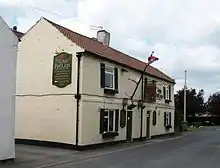
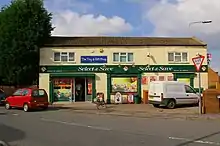
There are a few local convenience stores, a post office, a bakery and butchers, two takeaway outlets, a school & sports wear store, a pharmacy and doctors surgery, four public houses and a mobile library with internet access.
Since 1989 Holme Upon Spalding Moor Primary School has been twinned with a primary school in Lemgo, Germany. Once a year about 20 to 30 pupils visit Grundschule Hörstmar for one week.
There are several churches, the largest being All Saint's church which was mostly built in the 13th century. The church was designated a Grade I listed building in 1966 and is now recorded in the National Heritage List for England, maintained by Historic England.[7] There is also a Roman Catholic church, a Methodist church (formerly Primitive Methodist) and a Christian Fellowship church[8] in the village. The Zion (ex-Wesleyan) Methodist Church closed in 1987[9] and is now a private house.
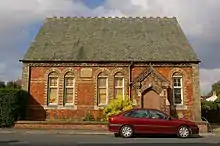
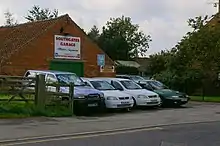
The village is served by bus services run by East Yorkshire Motor Services[10] and York Pullman.[11] The nearest railway stations are to the south of the village: Howden at 7.5 miles (12 km), and Eastrington at 5.5 miles (9 km).
Nearby Howden, Goole and Market Weighton contain amenities including supermarkets and a number of chain-shops. The nearest cities are York, Kingston upon Hull and Leeds.
The village's football team Holme Rovers was founded in 1922 by local residents and continues to exist. They play in the East Riding County League Premier division. The club won the top level of the York Football League during the 1962–63 season and the East Riding Senior Cup in 2007.
Notable people
- Marmaduke Langdale — prominent royalist commander of the English Civil War. Langdale had fought alongside Prince Rupert and the Marquess of Newcastle at the Battle of Marston Moor, before the war he was the High Sheriff of Yorkshire and later a Catholic convert. Awarded the title Baron Langdale of Holme in 1658 as his family was based at Holme Hall.
- Alec Horsley started Northern Dairies here.[12]
References
- UK Census (2011). "Local Area Report – Holme upon Spalding Moor Parish (1170211199)". Nomis. Office for National Statistics. Retrieved 20 February 2018.
- UK Census (2001). "Local Area Report – Holme upon Spalding Moor Parish (00FB070)". Nomis. Office for National Statistics. Retrieved 26 February 2020.
- Baines, Edward (1823). History, Directory and Gazetteer of the County of York. pp. 218, 219.
- Butt, R. V. J. (1995). The Directory of Railway Stations: details every public and private passenger station, halt, platform and stopping place, past and present (1st ed.). Sparkford: Patrick Stephens Ltd. ISBN 978-1-85260-508-7. OCLC 60251199.
- Historic England. "Holme Hall (1083338)". National Heritage List for England. Retrieved 15 August 2013.
- "St John the Baptist, Holme-on-Spalding-Moor". Diocese of Middlesbrough. Retrieved 4 August 2017.
- Historic England. "Church of All Saints (1025868)". National Heritage List for England. Retrieved 12 August 2013.
- "Holme Christian Fellowship". Retrieved 4 August 2017.
- "Marriage Acts Notices". The London Gazette (51027): 10222. 12 August 1987. Retrieved 4 August 2017.
- "Service 34". East Yorkshire Motor Services. Retrieved 14 September 2011.
- "Local bus services". York Pullman. Archived from the original on 21 September 2011. Retrieved 14 September 2011.
- "Obituary: Alec Horsley". The Independent. 21 June 1993. Retrieved 2 July 2013.
- Gazetteer — A–Z of Towns Villages and Hamlets. East Riding of Yorkshire Council. 2006. p. 7.
External links
 Media related to Holme-on-Spalding-Moor at Wikimedia Commons
Media related to Holme-on-Spalding-Moor at Wikimedia Commons- Holme-on-Spalding-Moor in the Domesday Book
- Holme On Spalding Moor History
- RAF Holme On Spalding Moor Airfield